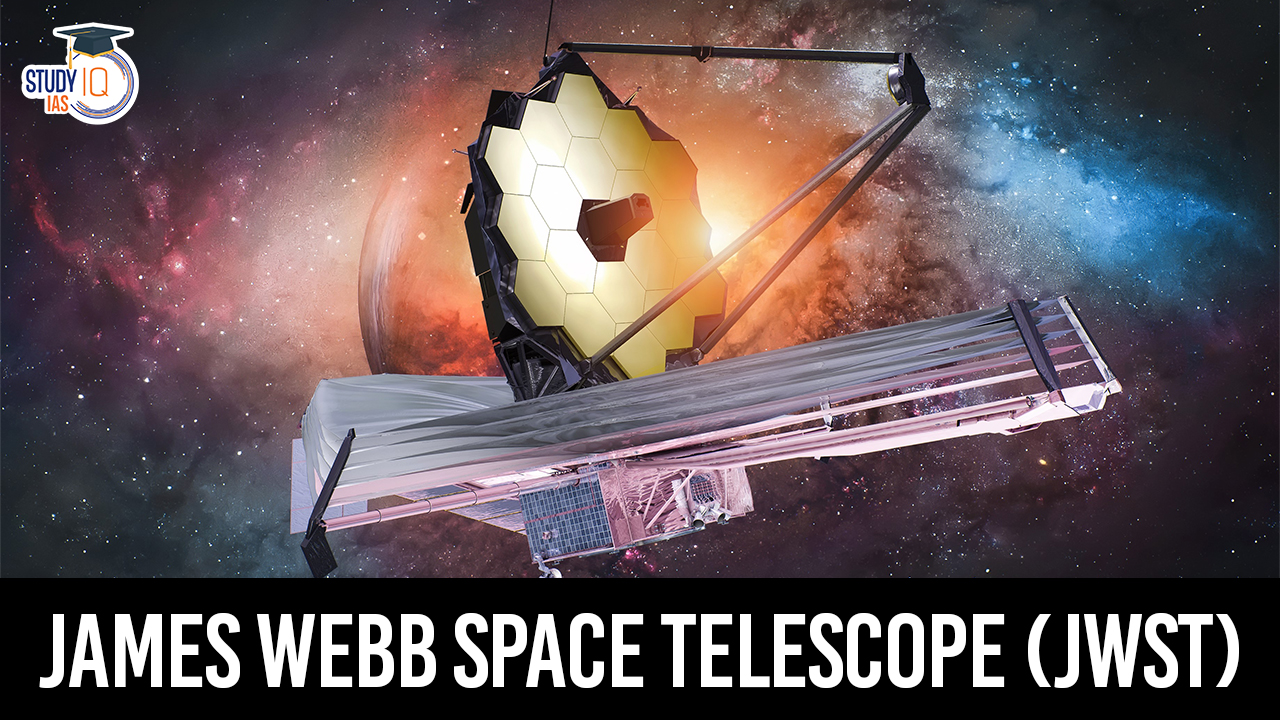Table of Contents
Context: An international team of researchers using NASA’s James Webb Space Telescope (JWST) and the Chandra X-ray Observatory has discovered an unusual supermassive black hole, designated LID-568, which challenges existing theories of black hole formation and growth.
About Supermassive Black Holes
- They are the largest type of black hole, found at the center of most galaxies.
- They contain millions to billions of times more mass than the Sun.
- Eg. – Sagittarius A, located at the centre of the Milky Way. It has a mass of approximately 4.3 million solar masses.
Discovery of LID-568
- LID-568 is a low-mass supermassive black hole that existed 1.5 billion years after the Big Bang, a time when the universe was just 8 years old.
- Observational Highlights:
- It was discovered using the Chandra X-ray Observatory due to its exceptional brightness in X-rays.
- JWST’s sensitivity in the infrared spectrum enabled researchers to study its properties further.
- LID-568’s accretion rate exceeds the Eddington limit by a factor of 40, making it an extreme example of super-Eddington behaviour.
- Accretion rate: It refers to the rate at which matter falls onto a black hole, measuring how much mass is being added to the black hole per unit of time. It is expressed in units of solar masses per year.
| Eddington Limit |
|
James Webb Space Telescope (JWST)
Launched on December 25, 2021, from South America’s coast, NASA’s James Webb Space Telescope enters a solar orbit 1.6 million km from Earth, four times farther than the moon. Over a two-week journey, it maintains alignment with Earth while circling the sun. In contrast, its predecessor, the Hubble Space Telescope, orbits Earth every 90 minutes from a mere 550 km away. Webb’s focus on infrared astronomy offers unprecedented insights into cosmic phenomena.
| Aspect | Details |
| Launch Date | December 25, 2021 |
| Operator | NASA |
| Collaborators | European Space Agency (ESA), Canadian Space Agency (CSA) |
| Purpose | Serve as the premier space-based observatory for the next decade |
| Telescope Type | Space telescope |
| Size | Largest space telescope ever built |
| Observational Spectrum | Primarily focused on the infrared spectrum |
| Resolution | Unprecedented resolution and sensitivity |
| Exploration Goals | Probe the universe’s earliest phases |
| Significance | Marks a new era in understanding the cosmos |
We’re now on WhatsApp. Click to Join
Features of James Webb Space Telescope (JWST)
At the heart of JWST lies a suite of cutting-edge features and technological innovations, each meticulously crafted to unlock the secrets of the cosmos:
- Infrared Optimisation: JWST is tailor-made for infrared astronomy, enabling it to peer through cosmic dust clouds and capture the faintest glimmers of light from the farthest reaches of the universe.
- Large Primary Mirror: With a colossal 6.5-meter diameter primary mirror, JWST boasts unparalleled light-gathering capabilities, allowing it to capture high-resolution images of celestial objects with unprecedented clarity.
- Segmented Mirror Design: The primary mirror comprises 18 hexagonal, gold-coated beryllium segments, ingeniously engineered to fold during launch and unfold seamlessly in space, maximizing its observational potential.
- Sunshield Protection: Shielded by a five-layer sunshield, JWST remains insulated from the sun’s intense heat, maintaining its delicate instruments at frigid temperatures necessary for infrared observations.
- Location at Lagrange Point 2 (L2): Positioned at the Sun-Earth L2 point, JWST enjoys a stable orbit free from terrestrial interference, ensuring uninterrupted observations and minimizing the need for fuel-consuming orbital corrections.
- Cryogenic Cooling System: Employing a passive cooling system, JWST achieves temperatures as low as 40 Kelvin (-233°C), essential for conducting precise infrared observations.
- Precision Guidance Sensors: Equipped with state-of-the-art guidance sensors, JWST ensures pinpoint accuracy in its observations, vital for studying faint celestial objects over prolonged durations.
- Extended Wavelength Coverage: With the capability to observe wavelengths ranging from 0.6 to 28 micrometers, JWST offers a comprehensive view of the cosmos, spanning from the visible to the far-infrared spectrum.
Objectives of James Webb Space Telescope (JWST)
The overarching objectives of JWST encompass a broad spectrum of scientific inquiries, including:
- Early Universe Exploration: JWST seeks to unveil the cosmic dawn by peering back in time to witness the formation of galaxies mere moments after the Big Bang.
- Galactic Evolution: By scrutinizing galaxies across cosmic epochs, JWST aims to unravel the intricate tapestry of galactic evolution, from their nascent beginnings to their present-day configurations.
- Star Formation and Planetary Systems: JWST’s keen gaze extends to the cradles of star formation, shedding light on the processes that give birth to stars and planets, ultimately elucidating the origins of planetary systems.
- Search for Extraterrestrial Life: Through meticulous examination of exoplanetary atmospheres and chemical compositions, JWST endeavours to discern the telltale signs of habitability, offering tantalizing clues in the search for extraterrestrial life.
Significance and Implications of JWST
The James Webb Space Telescope holds profound significance for humanity, transcending the boundaries of scientific inquiry:
- Advancement of Astrophysical Knowledge: JWST’s groundbreaking observations promise to revolutionize our understanding of the cosmos, paving the way for paradigm-shifting discoveries in astrophysics.
- Exploration of Exoplanetary Worlds: By probing the atmospheres of distant exoplanets, JWST heralds a new era in the quest to uncover the prevalence and diversity of life beyond our solar system.
- Global Scientific Collaboration: The collaborative spirit embodied by JWST underscores the power of international cooperation in advancing scientific frontiers, and fostering unity amidst diversity in the pursuit of knowledge.
- Inspiration for Future Exploration: As a beacon of human ingenuity, JWST inspires future generations to reach for the stars, catalyzing ambitious space missions yet to come.
Key Observations and Scientific Milestones of JWST
Already, the James Webb Space Telescope has made remarkable strides in its quest to unravel the cosmos, yielding breathtaking images and groundbreaking discoveries:
- Galaxy Cluster Observations: JWST’s keen eye has captured the essence of a galaxy cluster that coalesced 4.6 billion years ago, offering a tantalizing glimpse into the universe’s primordial epochs.
- Deepest Infrared Image: In a feat of astronomical prowess, JWST has unveiled the deepest and most detailed infrared image ever captured, revealing ancient galaxies lurking at the edge of cosmic oblivion.
- Discovery of ‘Monster’ Galaxies: JWST’s discerning gaze has identified a cadre of ‘Monster’ galaxies, behemoths that emerged mere hundreds of millions of years after the Big Bang, shedding light on the universe’s tumultuous infancy.
JWST vs. Hubble: A New Frontier
In comparison to its illustrious predecessor, the Hubble Space Telescope, JWST represents a quantum leap forward in observational capabilities:
| Feature | James Webb Space Telescope (JWST) | Hubble Space Telescope |
| Launch Date | December 25, 2021 | April 24, 1990 |
| Launch Location | South America’s northeastern coast | Kennedy Space Center, Florida, USA |
| Orbit | Solar orbit approximately 1.6 million km from Earth | Earth orbit at approximately 550 km altitude |
| Primary Mission | Infrared observations | Optical and ultraviolet observations |
| Primary Mirror Diameter | 6.5 meters | 2.4 meters |
| Primary Mirror Material | Gold-coated beryllium segments | Glass |
| Cooling System | Cryogenic cooling system, reaching temperatures as low as 40 Kelvin | Passive cooling system, aided by external radiator panels |
| Location During Observations | Second Lagrange point (L2) | Low Earth orbit |
| Primary Targets | Early universe, exoplanet atmospheres, star formation | Deep space objects, galaxies, nebulae |
- Infrared Capabilities: While Hubble is predominantly observed in the visible and ultraviolet bands, JWST’s optimized infrared capabilities enable it to penetrate cosmic dust clouds and unveil the universe’s hidden secrets.
- Mirror Size and Light-Gathering Capability: With a primary mirror more than double the size of Hubble’s, JWST boasts unparalleled light-gathering capability and resolution, empowering it to detect fainter and more distant objects with unparalleled precision.
- Location and Sensitivity: Situated at the second Lagrange point (L2), JWST enjoys a stable vantage point free from terrestrial interference, while its enhanced sensitivity enables it to probe the cosmos with unprecedented depth and clarity.
Beyond JWST: Exploring the Cosmic Frontier
In the pantheon of space-based observatories, JWST and Hubble stand as pioneers, but they are not alone:
- Chandra X-ray Observatory: Since its launch in 1999, Chandra has delved into the high-energy realms of the universe, unveiling the secrets of celestial phenomena invisible to optical telescopes.
- SPHEREx: Set to launch in 2024, SPHEREx promises to survey the cosmos in optical and near-infrared light, unravelling the mysteries of cosmic evolution and the origins of celestial bodies.
Conclusion
As humanity stands on the threshold of a new era in cosmic exploration, the James Webb Space Telescope stands as a beacon of hope and discovery, poised to unveil the universe’s deepest mysteries and inspire generations to come. With its unparalleled capabilities and unwavering resolve, JWST heralds a new chapter in humanity’s quest to unravel the enigmatic tapestry of the cosmos.


 What are Polycyclic Aromatic Hydrocarbon...
What are Polycyclic Aromatic Hydrocarbon...
 MALE Class Drones: Capabilities, Payload...
MALE Class Drones: Capabilities, Payload...
 Bluetooth Mesh Networking, Key Features,...
Bluetooth Mesh Networking, Key Features,...





















